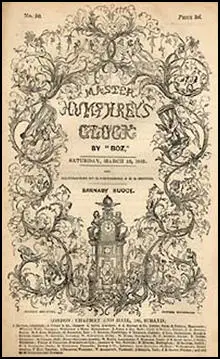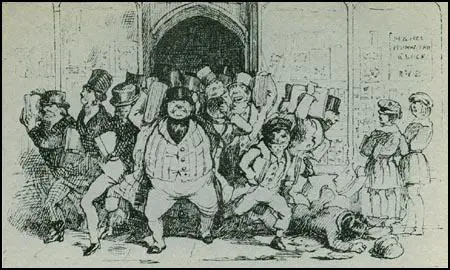Master Humphrey's Clock
Charles Dickens agreed a contract with William Hall, the part owner of Chapman and Hall, to edit a weekly magazine, Master Humphrey's Clock . Hall agreed to pay him £50 for each issue, plus half the profits. Dickens planned to commission work from other writers and to contribute short stories and occasional essays himself. The magazine was to be sold in America and Europe and Dickens expected to make something like £5,000 a year from the venture.
The magazine sold 70,000 copies when it was published for the first time in April, 1840. William Macready commented that it might be "too good for so wide a circulation". Customers were disappointed by the fact that Dickens only contributed the occasional article and sales fell dramatically. Dickens wrote to a friend that "day and night the alarum is in my ears, warning me that I must not run down... I am more bound down by this Humphrey than I have ever been yet - Nickleby was nothing to it, nor Pickwick, nor Oliver - it demands my constant attention and obliges me to exert all the self-denial I possess."
Charles Dickens decided he had to be the sole contributor and that he had to produce a full-length serial like The Pickwick Papers , Oliver Twist and Nicholas Nickleby for the journal to be a success. He decided to develop a short-story, The Old Curiosity Shop , that appeared in an early edition, into a serial. It was not long before the whole of Master Humphrey's Clock was taken up by the story. The magazine now had a circulation of 100,000. Dickens later explained: "In writing the book I had it always in my fancy to surround the lonely figure of the child (Nell) with grotesque and wild, but not impossible companions, and to gather about her innocent face and pure intentions associates as strange and uncongenial as the grim objects that are about her bed when her history is first foreshadowed."

The story, illustrated by Hablot Knight Browne, tells of Nell Trent, a small and delicate child of "angelic purity of character and sweetness of disposition" who lives alone with her grandfather, an old man, who is the proprietor of the Old Curiosity Shop. In an attempt to provide for Little Nell he becomes a gambler. He loses heavily and borrows money from Daniel Quilp, a rich dwarf, pledging his shop and stock as security for the debt. His luck does not change and he loses his home and business.
Little Nell now takes charge and persuades her grandfather to lead him away from London and the temptation of the gaming tables. While they are wandering the country they meet Mr Marton, a kind-hearted schoolmaster. He is travelling by foot to a distant village, where he has been appointed as a teacher of the local school. After hearing their story, Marton invites Nell and her grandfather to accompany him, promising to help them find work in the village. He manages to do this and they are giving a pleasant home and employment connected to the parish church.
After the publication of The Old Curiosity Shop , the critic, R. Shelton MacKenzie suggested that: "Little Nell, who is thought of by readers rather as a real than a fictitious personage... She is an idyllic impossibility... She is only too perfect - and her death is worthy of her life. Many a tear has been drawn forth by her imaginary adventures." Another critic writing at this time, Blanchard Jerrold, argued: "The art with which Charles Dickens managed men and women were nearly all emotional. As in all his books, he drew at will the tears of his readers... There was something feminine in the quality that led him to the right verdict, the appropriate word, the core of the heart of the question in hand... The head that governed the richly-stored heart was wise, prompt, and alert at the same time."

of Master Humphrey's Clock (16th April 1840)
On 13th February 1841, the first episode of Dickens's next novel, Barnaby Rudge , was published in Master Humphrey's Clock . It was his first attempt at writing an historical novel. The story opens in 1775 and comes to its climax with a vivid description of the Gordon Riots. On 2nd July, 1780, Lord George Gordon, a retired navy lieutenant, who was strongly opposed to proposals for Catholic Emancipation, led a crowd of 50,000 people to the House of Commons to present a petition for the repeal of the 1778 Roman Catholic Relief Act, that had removed certain disabilities. This demonstration turned into a riot and for the next five days many Catholic chapels and private houses were destroyed. Other buildings attacked and damaged included the Bank of England, King's Bench Prison, Newgate Prison and Fleet Prison. It is estimated that over £180,000 worth of property was destroyed during the riots.
Hall employed Hablot Knight Browne and George Cattermole to provide the illustrations. Browne produced about 59 illustrations, mainly of characters, whereas Cattermole's 19 drawings were usually of settings. Jane Rabb Cohen, the author of Dickens and His Principal Illustrators (1980) has argued: "At the story's climax, Dickens really let his imagination go in describing the orgiastic riots, Browne readily caught his spirit. His designs, with their tumultuous crowds yet individualized participants, fully embodied the violent excitement of the prose." Robert L. Patten has pointed out that woodblocks were used for the magazine and could withstand up to 100,000 impressions, but it has been argued that they lacked the character and freedom of copperplate plates used by artists at the time.
John Forster claimed that the last section of the book deserved the highest praise: "There are few things more masterly in his books. From the first low mutterings of the storm to its last terrible explosion, the frantic outbreak of popular ignorance and rage is depicted with unabated power. The aimlessness of idle mischief by which the ranks of the rioters are swelled at the beginning; the recklessness induced by the monstrous impunity allowed to the early excesses; the sudden spread of drunken guilt into every haunt of poverty, ignorance, or mischief in the wicked old city, where such rich materials of crime lie festering."
Charles Dickens hoped that it would become as popular as the historical novels of Sir Walter Scott. The Dickens's scholar, Andrew Sanders, has argued: "With Barnaby Rudge Dickens laid serious claim to be the heir of the most popular novelist of the generation before his own: Sir Walter Scott. Despite the slow beginning, which establishes character, the historical situation, and the idea of mental and moral dysfunction, Dickens's narrative first flickers and then blazes with something akin to the fire with which the rioters devastate London."
The public did not like the story and sales of Master Humphrey's Clock fell dramatically after the publication of the first episode. In August 1841 Dickens and his personal agent, John Forster , had a meeting with William Hall about the disappointing sales and it was agreed that the journal would be closed down when Barnaby Rudge came to an end. However, Dickens promised Chapman and Hall that they could publish his next novel, Martin Chuzzlewit . The terms of the agreement were very generous with Dickens being paid for each monthly installment, would receive three quarters of the profit and retain half the copyright.
